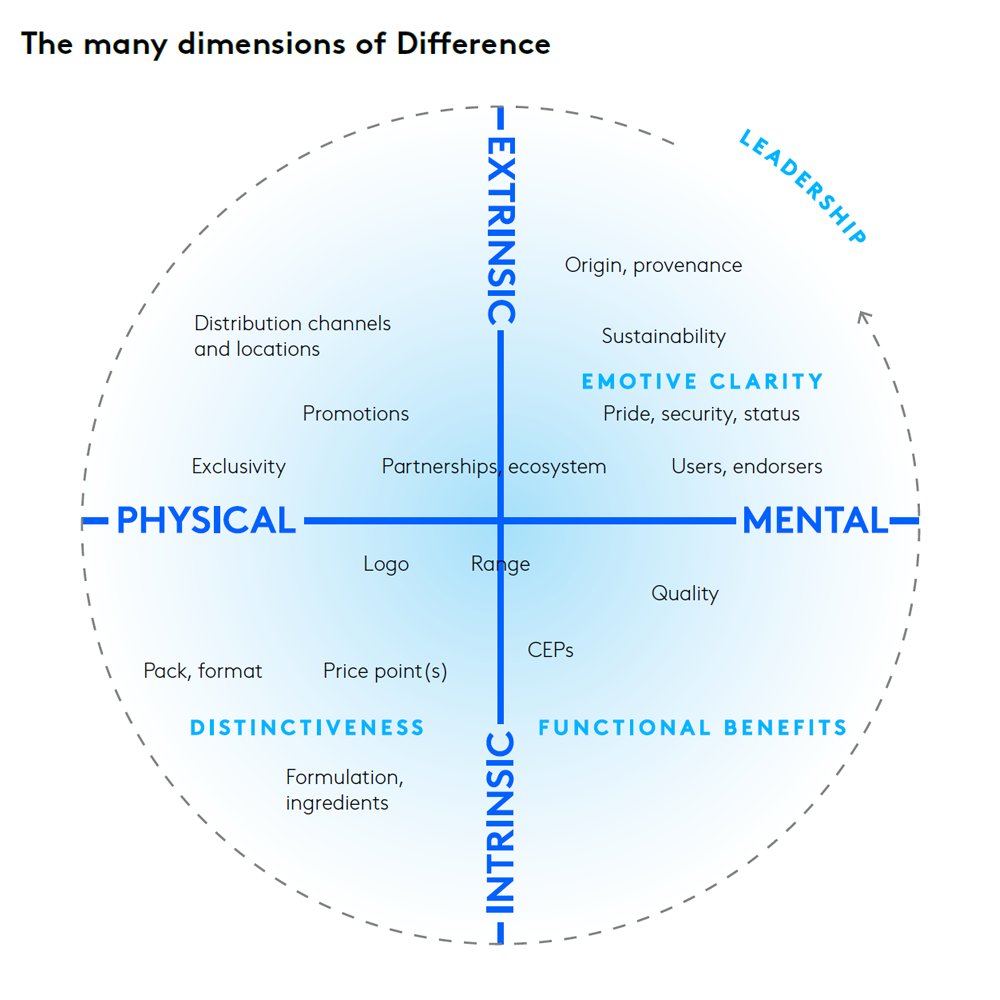By their very nature, brands build mental connections with consumers. When strong enough, these mental connections encourage people to buy the brand again, more frequently – and potentially for a higher price.
These connections can be quantified, too, by using Kantar’s Meaningful Different Salient framework. Through this framework, we can measure how well brands are: meeting emotional and functional needs (Meaningful), coming readily to mind (Salient), and standing out from competitors (Different).
This last element, Difference, might seem like a tall order for brands in our connected age, in which good ideas can spread (and spawn imitators) at warp speed. But in fact, to be rated as Different, a brand doesn’t have to be absolutely unique in every way.
What the data does show is that for growing businesses, there does have to be something in people’s memory separating this brand from that brand – and brands that fail to articulate these distinctions risk falling behind.
Difference is a predictor of share growth
Drawing on Kantar BrandZ’s vast database of consumer perceptions, we tracked a group of 1313 brands over a period of three to four years. Among those that increased their market share during this time, there is a clear pattern in the brand equity they had to start with. Namely: this growing group started out with a higher Difference compared to their Meaningful and Salient scores.
In other words, these were the brands that, from the start of our measurement period, had the strong potential to stand out memorably in consumers’ minds – and had huge upsides for growth once this difference became better known and more meaningfully articulated.
From there, we looked at the relationship between initial Difference scores and growth – and found that brands with strong Difference were twice as likely to grow as brands with weaker Difference.
But Difference alone only gets you so far. In order to grow, brands need to:
- Ensure their Difference is relevant to people and can play a role in their lives
- Ensure people know about these emotional and functional benefits
Take Tesla. Relatively unknown until recent years, Tesla always had a very strong point of Difference. Its EV expertise and innovation credentials were clear, but people didn’t see how these cars could work for them.
That changed as Tesla gradually became more relevant to people, helped along by the evolution of EV infrastructure: it grew +42 Meaningful index points and +26 Salient index points over four years in the USA. Today, Tesla continues to strengthen its brand equity to support longer-term growth.

Difference is important – but how do brands build it?
Recently, an even wider investigation by Kantar Analytics Practice looked at 11,000 brand cases to uncover insights about brand growth. And what Kantar found was that there are many ways brands can drive Difference.
In particular, brand structures analysis identified four leading strategies:
Category Leadership: Setting the trends and challenging the status quo
Distinctiveness: A highly distinctive look and feel and a suite of assets to reinforce this
Emotive clarity: Building clear and strong emotional connections with consumers
Functional benefits: Superior qualities that can help to set them apart from others
But there are many other ways to drive Difference beyond this ‘big four’. Some of these aspects are physical, perceptible, and easily measured. Others are mental, existing in the minds of consumers: their memories, knowledge, feelings, and experiences.
Characteristics that contribute to a sense of Difference can be intrinsic: baked into the design, formulation, and intent of the brand. But they can also be extrinsic, drawing on associations borrowed from the outside world and consumers’ social context.
These many varied factors interact with each other. For example, a brand's price point, provenance, or exclusive distribution might connote quality. Similarly, a promotion using a celebrity athlete endorser might simultaneously highlight a key ingredient of a brand, which in turn can be leveraged to connote superior speed or performance.
Communications are clearly essential to educating consumers about the physical qualities of a brand’s offerings: qualities like ingredients, pack design, promotions, or even where to find the brand. But communications can also tell stories and continue to build important associations, whether that’s around superior performance, category entry points, identification with user groups or simply a recognizable personality. Similarly, we find that innovation, CX management, and pricing policy can create a difference in the mind of the consumer.

Difference in action
What are some real-world examples of the many dimensions of Difference?
Category leadership: There are many brands in the Kantar BrandZ Most Valuable Global Brands set that have strong leadership credentials. But TikTok is the media and entertainment brand in our global ranking that is best known for ‘shaking things up’ and really leading the way with its creativity, superior algorithm, and association with ‘viral’ trends.
Distinctiveness: Louis Vuitton has some of the most distinctive assets in the world, and successfully leverages these ‘brand icons’ across its many ranges and partnerships (and also within its emerging forays into spaces like the metaverse). Luxury brands in general tend to have strong assets – and the brands that leverage theirs effectively tended to demonstrate more resilience over the past year.
Functional benefits: Superior taste has an important role to play in supporting Difference for food and beverage brands. Doritos is particularly known for its superior flavor, standing out from other snacking brands in this regard. At the same time, Doritos also has strong distinctive assets, like its triangle shape – demonstrating that brands can simultaneously leverage multiple aspects to build their Difference.
Emotive clarity: Brands that clearly embody one or two distinct, emotionally-driven personality types tend to do better than brands that straddle too many personalities or don’t have much of a strong personality. Disney+, for example, has stood out by mirroring its parent brand’s consistent personality archetypes. Thanks to its strong heritage, Disney is known as a ‘Joker’ or a ‘Free Spirit’ in every market covered by the Kantar BrandZ database. Ultimately, brands with strong emotive clarity are seen to be far more different than others – and are hence more likely to justify their prices.
Does your brand impart a sense of Difference?
Difference is one of the biggest challenges facing marketers today. It’s about more than simply being distinctive to aid your physical availability. Instead, brand marketing must build and consistently activate the many ‘differences’ that bring a brand to mind more easily.
Over the longer term, brands must work to refresh and reinforce those particular aspects of Difference that support higher margins in their categories. That’s because Difference is, in addition to its other virtues, a major driver of Pricing Power.
For an overarching view of brand performance, Kantar has launched a new, free interactive tool powered by BrandZ’s wealth of data and the Meaningful Different Salient framework. Kantar BrandSnapshot delivers intelligence on 10,000 brands in more than 40 markets, offering a quick read on a brand’s performance in a category. Explore for free on Kantar Marketplace today.



